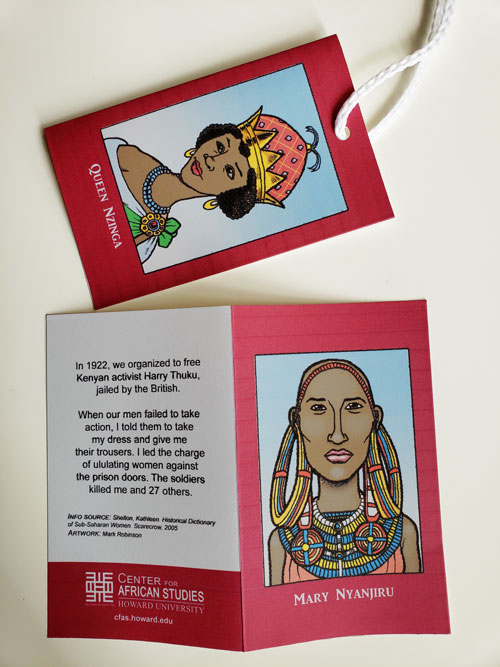Voices from Africa: Colonized Women Talk Back
Introduction
This 3-part lesson introduces students to African women who challenged colonial rule. It debunks the myth of the submissive African woman.
Objectives
- Students will understand that the struggle against colonialism included women and was a collective effort involving multiple strategies.
- Students will be able to identify major women leaders in the struggle against colonialism in the context of a larger movement.
- Students will explore similarities and differences between African women activists and the experiences of civil rights activists in the United States.
Lessons
Lesson 1: The Activist Speaks
Lesson 1: Students play the role of an African woman who protested colonial rule.
Materials Needed
- Colonized Women Badges (See instructions for making them below.)
- Listening Organizer PDF
- Discussion Questions (below)
Procedure
- Distribute badges, one to each student. Students silently read the information on the back of the badge. Provide assistance if students need help pronouncing names or words. If you have more than 23 students you can assign several students to the following groups: Abeokuta Women’s Union, Women’s March on Bassam, Women’s March on Pretoria. The students can read the statements in unison or divide up the sentences.
- Call each activist’s name. Students step forward and read/dramatize their statements. The other students should use the Listening Organizer to record significant information as the person speaks.
- After all the names have been called, engage students in post discussion questions.
Discussion Questions
- How did you feel when reading the statement?
- What are the women fighting for/against?
- What are their common traits or characteristics?
- What strategies did the women use?
Lesson 2: Which Activist am I?
Lesson 2: Students match the description with the activists.
Materials Needed
- Colonized Women Badges (See instructions for making them below.)
- Clue Sheet PDF
- Answer Sheet PDF
- Clip Board
Procedure
- Redistribute the Colonized Women Badges.
- After distributing the Badges, encourage students to carefully read and memorize the name of the person on their badge. Allow students quiet time to memorize the name and important facts about the person’s life from the back of the card.
- Distribute the clue sheet ( a clipboard is helpful).
- Students use the descriptions on the Clue Sheet to query the other students, e.g. “Did you rise to power in the 16th century Kongo Kingdom?” They only answer with yes or no.
- When the description matches the activist, the students write the name of the activist on the Clue Sheet in the blank space provided.
- Model the process with a student.
- Tell students to put on their name badges and begin.
- When most of the students have finished or there are only ten minutes left in the class period (whichever comes first), end the activity.
- Ask students to take their seats. Share the correct answers.
- Ask students to share some reflections about the activity. You can prompt the discussion with questions such as: What did you learn that surprised you? What did you know already? What new information did you learn?
- Close by explaining that the next time you meet, students will research one of the women activists.
Lesson 3: Research an Activist
Lesson 3: Students conduct in-depth research on an African woman activist.
Resources
-
Menkart, Deborah. Putting the Movement Back into Civil Rights Teaching. Teaching for Change, 2004.
-
Sheldon, Kathleen. The A to Z of Women in Sub-Saharan Africa. Scarecrow Press, 2010.
-
Sheldon, Kathleen. Historical Dictionary of Sub-Saharan Women. Scarecrow Press, 2005.
-
UNESCO Women in African History. https://en.unesco.org/womeninafrica/. U.N. Educational, Scientific & Cultural Organization
Procedure
- Students can create a list of questions of what they would like to know about the woman they represented.
- Students can use the resources noted above and Internet resources to find the answers to their questions.
- The teacher can identify a format for the students to document and share what they have learned.
- Once the students have learned more about their African activist, the teacher and students can discuss and answer the following questions.
- What qualities do social justice activists possess?
- What were the issues and forms of repression addressed by women activists?
- How did the women demonstrate their courage? Name various ways.
- Identify sources of inspiration, skills, organizing strategies, and experiences of women activists.
- Compare the list you made above to the sources of inspiration, experiences, skills, organizing strategies, and experiences of civil rights activists in the United States. Make a list of similarities. Then make a list of differences.
Instructions: Making the Badges

Below are instructions for making the badges for the Colonized Women Talk Back lessons.
Materials needed:
- PRINTABLE BADGES PDF
- Printer
- Cardstock paper
- Scissors or a paper trimmer
- Double stick tape
- Hole puncher
- Ribbon
Instructions:
- Print the PRINTABLE BADGES PDF on cardstock.
- Cut out the cards. There are 2 cards (front and back) per page. The front has the image and the back has the description.
- Fold the cards in half, so that the front image is on one side and the back description is on the other side.
- Place a piece of double stick tape inside each badge to keep it from opening up.
- Punch a hole at the top of each card.
- Tie a ribbon through the hole and you're done.
* Pronunciation assistance for African names is available through Title VI African Studies Centers.
Created by Brenda Randolph, 2015
Updated 2019 Thanks to Vanessa Oyugi and Lesina Martin
